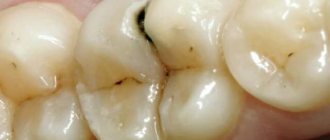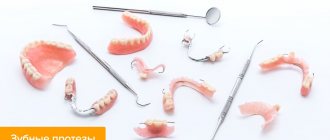During the examination, the dentist may suggest that you replace the previously installed filling with a new one. This proposal is often misunderstood:
“Doctor, this tooth doesn’t bother me, and the filling is still holding. Why change it?!”
To understand why replace an old filling with a new one, let’s figure it out: what is the function of the filling and why was it placed in the first place?
The filling restores the function of the tooth, aesthetics, protects the pulp (dental nerve) from infection, and the tooth from further destruction.
If the destruction of enamel and dentin has gone so deep that it has approached the pulp of the tooth, the “nerve” will need to be removed. “But it can be treated,” you say. Of course, the doctor will remove the tooth pulp, fill the canals and put a filling. You will learn more about canal treatment in the article Why you cannot give a 100% guarantee on tooth root canal treatment.
The problem is that after complex, lengthy and expensive root canal treatment, the tooth will become “dead” - these are not empty words. After removal of the pulp, hard tissues cease to be moistened and the walls of the tooth become fragile. Pulpitis shortens the lifespan of your tooth.
Now let's get back to replacing the old filling with a new one. The main reason for replacing an old filling with a new one is the loss of tightness of the filling of a former carious cavity. If the old filling does not prevent infection from entering the tooth, then the carious process resumes, and we already know what the consequences are.
Secondary caries develops unnoticed and cannot be detected without examination by a dentist.
In what other cases is it necessary to replace an old filling with a new one?
Is a refilling necessary if nothing bothers me?
Many patients are surprised when a dentist recommends replacing an old filling with a new one, because they have no pain or other unpleasant symptoms. However, replacement is carried out not only in cases of severe inflammation, but also for preventive purposes, as well as to improve the aesthetics of the dentition.
Like any other material, the filling mass is subject to gradual wear, deformation, and destruction. Hygienic care, oral microorganisms, saliva pH, mechanical, chemical and temperature effects of food over time provoke the appearance of microscopic cracks in the filling. The resulting pores serve as a breeding ground for microbes and the development of dental diseases.
What are the consequences of insufficient filling strength?
The technology for making a filling (in the patient’s mouth) does not make it as strong as possible, so over time the filling material wears out.
As in the case of vertical shrinkage, abrasion of the filling can lead to problems:
- the level of bite changes , and this can lead to the chipping of part of the tooth due to the redistribution of the chewing load from the filling to the walls of the tooth.
- the boundary between the filling and the tooth tissue changes , while the filling loses its tightness and the infection penetrating inside provokes the development of secondary caries.
How long can a filling last?
The service life of a filling is determined by several factors, the main ones being the following:
- correct installation and size,
- characteristics of the material from which it is made,
- the condition of the abutment tooth, the thickness of its walls,
- features of hygienic care: brush hardness, abrasiveness of pastes, etc.
- the presence or absence of certain habits: for example, high consumption of nuts, seeds, opening corks with teeth,
- the predominance of solid and/or tough foods in the diet, and so on.
As a rule, the minimum service life is 3-5 years, but some materials can last 10 years or more. In fact, it depends more on the condition of the treated tooth itself after a while.
When is it time to replace an old filling?
The reason to contact a dental clinic is the appearance of the following symptoms:
- reaction of teeth to changes in food temperature;
- darkening of the enamel or the filling itself, chips, mobility;
- constant bad breath;
- bleeding, inflammation or discoloration of the gums.
The presence of secondary caries is difficult to detect during an external examination, so in dentistry a visiograph, a new generation device, is used for this purpose. He takes a picture of the tooth, and the data is processed by a computer program. Moreover, the radiation dose when using it is several times less than with a conventional x-ray examination.
Why does caries develop under the filling mass?
The development of a carious process under the filling material is often observed due to poor-quality treatment of the tooth cavity during treatment. The remains of the affected tissues serve as a source of infection, which intensifies and covers increasingly larger areas of the dentition unit.
Caries can also form if the filling is carried out in violation of the protocol. An incorrectly applied composition quickly becomes unusable, losing its fixation with the walls of the tooth cavity or collapsing under the influence of the aggressive environment of the oral cavity. Microbes penetrate into the resulting cracks and voids, which “trigger” the destructive process.
Another factor that provokes the development of caries is the natural “aging” of the filling. The appearance of microdamages (and micropores) on it and in it, which is inevitable over time, contributes to the accumulation of pathogenic bacteria, their reproduction, and the occurrence of recurrent disease. Therefore, it is advisable to replace old fillings with new ones after their expiration date.
Types of dental fillings
Classic filling of carious teeth involves the installation of a dental filling without depulpation of the root canals. This technique is used for minor mechanical and carious damage to the tooth (superficial and medium caries) and is carried out in several stages.
When the dental pulp is damaged, in most cases it is necessary to fill the root canals of the teeth. In the case of milk and young molars, there are methods for preserving the functionality of the root - a biological method of treatment using calcium-containing preparations (tooth filling with calcium) or partial amputation of the pulp. This allows you to maintain the blood supply to the tooth and its vitality, which is especially important when it is in the development stage.
Depulpation involves removing the tooth root, cleaning and developing the canals with special instruments and filling them with artificial materials in order to eliminate the risk of developing inflammatory processes. There are various methods of root canal treatment. There is no absolutely ideal method, so the doctor focuses on a specific clinical case.
What types of fillings are there?
Today, various materials are used to fill teeth. The most widespread are the following:
- cement: it is cheap, therefore it is actively used in the budget dental field. Fillings made from this material are susceptible to destruction, short-lived (maximum - 1-2 years), when replacing them, doctors often diagnose a carious process,
- amalgam: based on mercury, copper and silver. They are characterized by high strength, but the appearance leaves much to be desired. In addition, mercury is a toxic substance,
- <>photopolymers: the most modern option. They harden in the light, are durable, highly aesthetic and natural in appearance. On average, they last about five years,
- chemically cured composites: the material cures on its own, without exposure to a blue light lamp (but can still be used to speed up the process). A very durable composition, most often applied to chewing areas - premolars and molars. Aesthetics worse than photopolymers,
- glass ionomer cements: differ from classical cements in a large number of advantages, because They last a long time, the price is not too high, they are low allergenic and can be installed for children.
Filling of anterior teeth
In the case of front teeth, the aesthetic aspect comes to the fore, so the filling material must have the appropriate properties. Although the front teeth receive better hygiene due to their accessibility, they are also susceptible to caries. Installing a filling on the front teeth is considered a more complex procedure: it is necessary not only to give the filling the desired shape, but also to choose the right color. In most cases, filling of anterior teeth is carried out using compomers, as well as light composite fillings, which harden under the influence of ultraviolet radiation. Be that as it may, in case of serious damage, it is impossible to achieve good aesthetics with the help of filling, so you often have to turn to orthopedic solutions.
When is a refilling required?
To determine when a filling needs to be replaced, you should contact your dentist. He will conduct a diagnosis, including x-rays, and, if necessary, carry out a replacement.
Indications for refilling are the following conditions:
- pain in a filled tooth,
- crown destruction,
- detection of caries under filling material,
- feeling of an unpleasant taste,
- decreased aesthetics of the restoration,
- expiration of the seal's service life.
The most common situations in which refilling is required are discussed below.
Changing Hue
Yellowness, darkening and other color changes in the filling (and enamel) most often indicate the presence of a destructive process in the tooth. If there is a reddish tint, it means that the previously installed material contains resorcinol - in this case, not only a refilling is required, but also additional cleaning of the canals, as well as an internal bleaching procedure.
Abrasion of the filling mass
Over time, the fillings wear out, which leads to disruption of the distribution of chewing load. As a result, the bite changes, the load on the temporomandibular joint increases, TMJ pathologies develop, and digestive problems arise.
Overhanging filling
If installed incorrectly, the filling material may “hang” over the adjacent tooth or gum. The accumulation of food particles and impaired contact between units of the dentition provoke an inflammatory process in soft tissues, the proliferation of microorganisms and the development of caries, and bleeding gums.
Subsidence of the filling mass
Shrinkage is typical for any materials used for filling. If it occurs along the axis of the tooth, a person’s bite may change, which will lead to problems with the TMJ and digestion. In addition, vertical subsidence provokes the appearance of cracks and even chips in the tooth, since, as the filling contracts, it “pulls” the hard tissues along with it. When subsidence occurs in the horizontal plane, the degree of contact between adjacent units changes, food debris gets stuck in the interdental spaces, the formation of caries and gum inflammation are observed.
Flat filling surface
If, when filling, the dentist did not pay due attention to the chewing surface, but made it flat, disruption of the chewing process will gradually lead to the development of problems with the gastrointestinal tract. Normally, there are cusps and fissures on it, which ensures full contact with the opposite teeth of the other jaw.
Roughness has appeared
The rough surface of the filling indicates the presence of pores and microscopic cracks in it. This means that microbes have already penetrated into it. Often, when the filling material is removed in such cases, caries is revealed underneath it.
Expired service life
Even if the filling was installed more than 10-15 years ago and still holds, it does not mean that it is fulfilling its function. In the vast majority of cases, when refilling such “rarities”, an extensive carious process is determined.
Unaesthetic appearance
Refilling may be required if the previously installed filling stands out in shade from the background of the remaining teeth. Most often, the situation occurs after the whitening procedure. Over the period of operation, old compounds have absorbed various coloring substances, so to restore the aesthetic appearance (especially of the front units), they need to be replaced.
Why do you need dental filling?
The first experiments with the installation of fillings were carried out before our era. Holes in the teeth were filled with resin and various mixtures. However, the archaic technique of filling teeth brought almost no positive results. Fortunately, today everything has changed dramatically. Modern fillings are successfully used to perform a variety of tasks, in particular for:
- functional filling
- aesthetic dental filling
- filling root canals
- temporary sealing of a damaged tooth
How does the replacement take place?
Many patients are worried: is it painful to change a filling? The procedure is performed under local anesthesia and is therefore absolutely painless.
In general terms, re-sealing occurs as follows:
- anesthesia is administered
- the desired tooth is isolated from the oral cavity with a rubber dam: so that moisture and microorganisms do not enter the treated cavity,
- old filling material and tissues affected by caries (if any) are removed
- the cavity is treated with a special etching solution and dried,
- an insulating or medicinal pad is applied,
- a new filling is applied.
Restoration takes place with mandatory consideration of the anatomical features of the chewing surface.
What does replacing a filling lead to?
What's wrong with changing the filling when needed? The problem is that you don’t know the exact time when the old filling stops performing its functions, but if part of the tooth breaks off, the doctor will be forced to put in a new, larger filling.
In the case of advanced caries and pulpitis, it may be necessary to remove the nerve, but a “dead” tooth is more fragile and fillings and inlays adhere less well to its tissues (which means the service life will be shorter).
We devoted the article Karis to the treatment of different stages of caries: what is it like? And why does treatment differ so much in price? Read it to understand how caries progresses.
With each filling replacement, the “native” tooth becomes smaller and the moment approaches when it can only be restored with a crown.
How to extend the service life of filling material
How often the filling will have to be changed depends on how correctly it is used. To extend the life of the material, just listen to the following tips:
- don’t skimp on material: very cheap means it won’t last long,
- avoid increased stress on the filling: do not open bottles, avoid excessively hard foods,
- avoid sudden changes in temperature in the oral cavity: do not take too hot or cold food,
- select oral hygiene items and products in accordance with the characteristics of the teeth.
In addition, even in the absence of complaints, you need to regularly visit the dentist for timely detection of pathologies and defects. It is better to spend a few minutes grinding than to have to refill it after some time. Preventative visits will save time and money, and will also keep your nerves and teeth in perfect order.
Why is a ceramic inlay better than a regular filling?
Unlike a filling, which a doctor makes in the mouth, an inlay goes through all stages of manufacturing in a dental laboratory. The dentist only processes the tooth cavity under the inlay and makes impressions of the jaws, and after making the inlay, glues it in place.
Restoring a tooth with an inlay requires two visits to the dentist, but ensures long-term functionality and aesthetic perfection of the restoration.
Advantages of ceramic inlays:
- Inlays do not shrink after placement because this process is completed during the manufacturing stage in the dental laboratory.
- Ceramic inlays have the highest strength and do not wear out over time, thanks to production technology. The inlay is pressed from a ceramic mass heated to high temperatures or machined from a single piece of ceramic.
- Inlays completely restore the anatomical shape of the tooth and chewing functions, thanks to the modeling of the bite in the articulator using casts of two jaws.
- Making an inlay with fitting on a plaster model makes it possible to create it without overhanging edges , restore tooth defects in hard-to-reach places, ensure correct interdental contact and good marginal fit of the inlay to the tooth. All this is difficult to do when making a filling in the oral cavity.
- All outer surfaces of the inlay (including those in contact with adjacent teeth) are perfectly ground before installation.
- It is easier to select the desired color and translucency of the inlay in the laboratory than in the patient’s mouth. Therefore, ceramic inlays are the best option for aesthetic dental restoration.
- The inlay is more reliably glued to the tooth, since the doctor requires a minimum of time to install an inlay of exactly the right size into the treated tooth cavity (due to the speed of installation, the risk of moisture and infection on the treated surfaces is reduced).
By restoring a tooth with a ceramic inlay, you get a high-quality, durable restoration and do not get tired during the appointment, since you do not need to sit for a long time with your mouth open.
For medical reasons, if the coronal part of the tooth is destroyed by more than 30%, it is recommended to install an inlay.
Installing a seal on a pin
More recently, it has become common practice in dentistry to install a filling on a post if the tooth is more than 50% destroyed. Thus, the technique made it possible to avoid prosthetics. Filling a tooth with a pin must be preceded by removal of the nerve. Then a special screw is inserted into the root canal and fixed with cement. The procedure is completed by layer-by-layer application of light-polymer composite materials. However, installing a pin does not guarantee reliability and safety. Over time, the cement breaks down, causing microbes to get under the filling, causing the formation of caries. Having chosen modern dentistry to install a filling, you are unlikely to encounter such technology.











